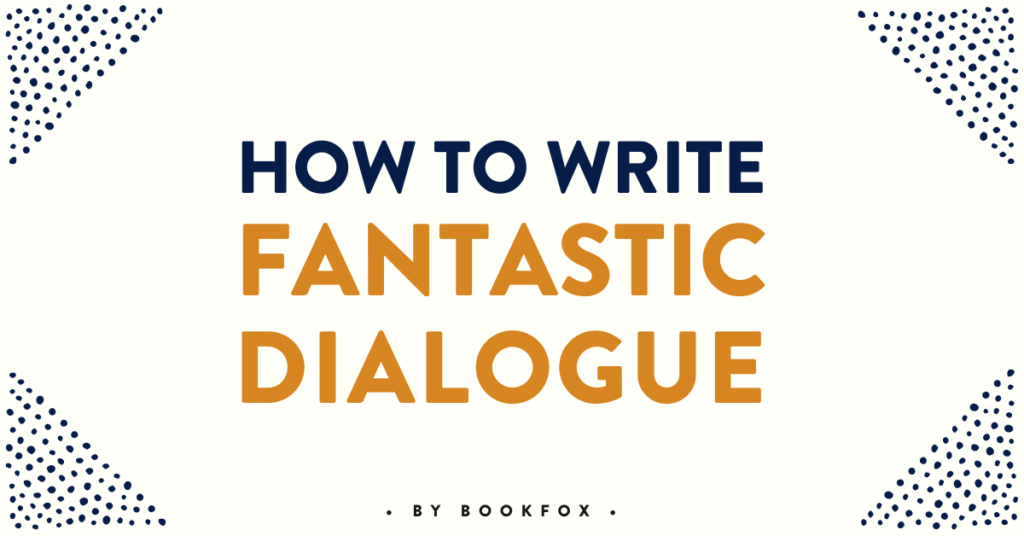
If there’s one essential element to make your fiction more entertaining, it’s writing better dialogue.
Dialogue entertains readers, delights agents, and thrills publishers.
If you have fantastic dialogue, it will cover a multitude of narrative sins.
I’d recommend bookmarking this post so you could come back to it (because I’m about to download a massive amount of help on your writerly soul).
Here’s what this post is going to cover:
- Make Characters Sound Different
- Double Up Your Dialogue
- Avoid Responsive Dialogue
- Characters Don’t Say What They Think
- Use Indirect Dialogue
- Dialogue IS Characterization
- Dialogue Includes Silence
- Create Dialogue Interjections
- Pace Your Dialogue
- Don’t Treat the Reader as Stupid
- Use Sidebar Dialogue
- Treat Dialogue like Plot
- Write “Burnt Tongue” Dialogue
- Repeat More
- Avoid Dialogue Tags
And keep reading until the end because I have a few surprises for you to wrap things up.
1. Make Characters Sound Different
Readers should be able to tell your characters apart just by the way the characters speak.
Use slang, sentence length, formality, and swearing to help your characters sound different.
Gary Shteyngart is fantastic at this. Take a look at two characters in Absurdistan:
“Why you got all these giant dicks around the house?”
“Those sculptures? Oh, I guess they’re all part of a Brancusian motif.”
“You a fudge-packer?”
“A what? Oh, no. Although homosexuals do number among my friends.”
One character uses low-brow slang for body parts and sexual identities.
The other uses words like “motif” and formal phrases like “do number among my.”
You could tell them apart even if the author never told you who was speaking.
Exercise: Take 3 lines of dialogue from each of your two main characters and put the lines in a separate file. Does the dialogue look different? Sound different? Could someone who hasn’t read the book tell these characters apart?
2. Double Up Your Dialogue
Great dialogue means two things at the same time.
Actually, this is kind of the secret superpower of dialogue, that it can mean multiple things at a time.
The fancy-pants word for this is subtext. The dialogue means one thing on the surface, and then has a deeper, hidden meaning.
Two strategies for doubling up your dialogue:
Write dialogue that means the opposite of what it says.
A young woman is bringing her much older boyfriend to meet her parents.
“I’m sure this will be fine.”
On the surface, she’s saying it will be okay. But this dialogue actually means that she suspects it won’t be fine at all.
Write dialogue that’s ambiguous:
A boyfriend and girlfriend have a fight at a restaurant, and he says to the waiter:
“We’re done.”
Does he mean that the meal is done, or that he’s fed up with the relationship?
Exercise: Write dialogue between two characters who are about to be executed. Don’t let them talk about their impending death at all, but only about their favorite foods. Make sure their discussion of their favorite food has an underlying meaning of their last hours.
3. Avoid Responsive Dialogue
Most writers have characters respond directly to what the other character says.
But the secret to great dialogue writing is to have both characters not respond to each other.
This seems wrong. This seems like it won’t make sense.
But trust me, your dialogue will sound fantastic.
In Dune by Frank Herbert, Jessica is talking about whether Chani is a good wife for her son:
Jessica swallowed past a sudden tightening in her throat. “Chani’s very dear to me,” she said. “She could be no–”
“Your rugs are very dirty in here,” Harah said. She swept her gaze around the floor, avoiding Jessica’s eyes. “So many people tramping through here all the time. You really should have them cleaned more often.”
In Junot Diaz, “The Brief Wondrous Life of Oscar Wao”:
My mother announced at dinner, quietly: “I want you both to listen to me: the doctor is running more tests on me.”
Oscar looked like he was going to cry. And my reaction? I looked at her and said: “Could you please pass the salt?”
Exercise: Write a one page scene where each of the characters refuse to respond to what the other one is saying. Give them both separate agendas that they want to discuss, and neither gives in to the other person’s topic.
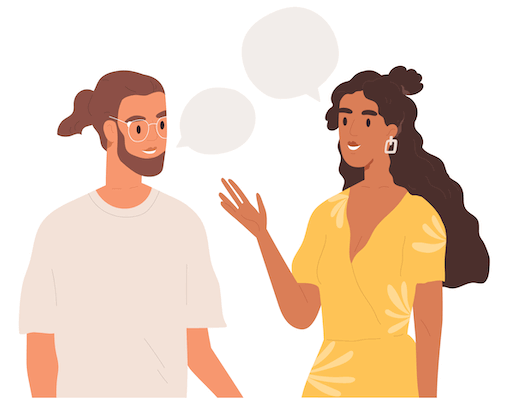
4. Characters Don’t Say What They Think
The worst dialogue writers take everything a character thinks and have them say it.
The best dialogue writers always have a gap between what a character says and what they’re actually thinking.
For example, when a terrorist takes a hostage:
Hostage: “Are you going to let me live?”
Terrorist: “Sure.”
That one-word reply is remarkably unconvincing, isn’t it? If I were the hostage, I would be 80% sure that man was lying.
The art of dialogue is the art of psychology. And any psychologist will tell you that people often don’t say what they mean or what they’re thinking.
For more examples of this, read my post on 50 Dialogue Examples — you will learn so many more helpful techniques.
Exercise: A husband comes home from work and his wife has just learned that he cheated on her. What would she say to him without revealing that she knows about his infidelity?
5. Use Indirect Dialogue
Most writers think direct dialogue (the stuff in quotes) is the only form of dialogue.
Not true!
Some of the best dialogue is called “indirect dialogue.”
This is dialogue that’s summarized.
“They walked and talked about the strange light of the sea, the soft warm lilac color of the water, and the golden pathway made by the moonlight.”
-Anton Chekhov, “The Lady with the Pet Dog.”
Indirect dialogue helps you cover a large amount of time and conversation by summing it up quickly. If you only use direct dialogue, you risk boring the reader.
Even intermediate writers often fall prey to only using direct dialogue, and completely botch the opportunity to speed up with indirect dialogue.
Here’s an example from Gillian Flynn’s Sharp Objects
“When the phone rang, I picked it up, just so Amma wouldn’t lose her momentum, and was surprised to hear the cheerleader staccato of my old friend Katie Lacey. Angie Papermaker was having the girls over for a Pity Party. Drink a bunch of wine, watch a sad movie, cry, gossip. I should come.”
See how there are no quotes? And no exact words of what her friend said?
That would be very dull and transactional dialogue if it were written out verbatim. But if it’s summarized, we get to hear what the protagonist is thinking.
6. Dialogue IS Characterization
The main purpose of dialogue is not to progress the plot.
The main purpose of dialogue is to make your characters feel real.
Joan Didion says: “Dialogue, as much as anything else, reveals the character to the writer, and, ultimately, to the reader. I don’t have a very clear idea of who the characters are until they start talking.”
Caryl Churchill, in her novel “Top Girls,” uses repetition to make her character come alive in a job interview:
“So just fill me in a bit more could you about what you’ve been doing.”
“What I’ve been doing. It’s all down there.”
“The bare facts are down here but I’ve got to present you to an employer.”
“I’m twenty-nine years old.”
“So it says here.”
“We look young. Youngness runs in our family.”
“So just describe your present job for me.”
“My present job at present. I have a car. I have a Porsche. I got up the M1 a lot. Burn up the M1 a lot. Straight up the M1 in the fast lane to where the clients are, Staffordshire, Yorkshire, I do a lot in Yorkshire.”
Look at how much repetition there is in this piece. The person being interviewed repeats herself or the interviewee 8 times. 8 times!
And that casual repetition really captures authentic speech.
We get a solid sense for how droll and uninspiring this 29-year-old is.
Exercise: Try writing dialogue where one character keeps repeating the exact same phrase throughout the whole conversation. Try one of these three phrases, no matter what the other person says.
- Are you sure about that?
- I don’t believe you.
- But I’m the greatest.
7. Dialogue Includes Silence
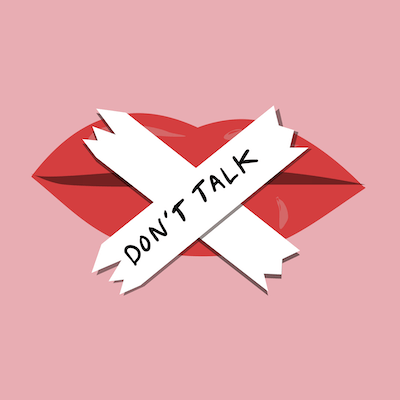
Silence speaks volumes.
Silence can communicate far more than any spoken words.
If you’re not including silence in your dialogue, you’re missing out on one of the best dialogue techniques.
Looking at Ernest Hemingway in “Hills like White Elephants,” where he has two characters talking about an abortion:
“It’s really an awfully simple operation, Jig,” the man said. “It’s not really an operation at all.”
The girl looked at the ground the table legs rested on.
“I know you wouldn’t mind it, Jig. It’s really not anything. It’s just to let the air in.”
The girl did not say anything.
Exercise:
Dialogue: Write dialogue with one speaker and one non-speaker. Show the non-speaker’s gestures, noises, body language and actions to off-set the speaker’s lines.
8. Create Dialogue Interjections
Make characters say signature interjections.
These are phrases that only they use, and they tell the reader something about who they are as a person.
- “Oh, my lungs and liver!” Charles Dickens, David Copperfield
- “Frack!” Battlestar Galactica
- “D’oh!” Homer Simpson from The Simpsons
- “Zark off.” Hitchhiker’s Guide to the Galaxy
- “Huzzah!” Phyllis in James Joyce’s Ulysses
- “Oh, my ears and whiskers!” White Rabbit in Alice’s Adventures in Wonderland
What a character shouts during a moment of duress tells you so much about them.
Do they swear? Do they say something innocent or funny?
Good characters might say “fiddlesticks,” while worldly/evil characters will swear like a deckhand.
9. Pace Your Dialogue
Most beginning writers all write the same length of dialogue. It’s all 1 – 3 sentences long.
But trust me – that gets boring.
Ideally, you should vary your dialogue pace. Your dialogue should go both fast and slow.
Here is fast dialogue. It’s from Bret Easton Ellis’s “Less Than Zero.”
“Don’t go,” she says.
“I’ll only be gone a couple of months.”
“That’s a long time.”
“There’s always summer.”
“That’s a long time.”
“I’ll be back. It’s not that long.”
“Shit, Clay.”
“You’ve got to believe me.”
“I don’t.”
“You have to.”
“You’re lying.”
“No, I’m not.”
You speed up your dialogue by writing “Volleys.” These are witty, short retorts back and forth without any action or description.
The reader rips through these and they feel smart because of how fast they’re reading.
Here is slow dialogue. Bruno is speaking in The Elementary Particles by Michel Houellebecq:
“For years my son turned to me for love and I rejected him. I was depressed, I hated my life, I thought there’d be a time when I felt better. I didn’t realize how quickly the years would go by. Between seven and twelve, a child is an astonishing being – kind, rational and open, full of joy and convinced that the world is a logical place. He’s full of love, and happy to accept what love we’re prepared to give. After that it all goes wrong – it all goes horribly wrong.”
This is just the beginning of a two-page dialogue. Nobody else is speaking – it’s just him droning on and on.
Three ways to slow dialogue down:
- Add thoughts/description between dialogue. For instance, a character could have one line of dialogue, then a whole paragraph of thoughts/description, and then the one character speaks one line of dialogue.
- Paragraph-Long Replies. You could also make it slow by having a whole paragraph of dialogue, then the other character speaks a whole paragraph of dialogue.
- Pay attention to sentence length. Short sentences tend to speed up dialogue, while longer sentences can slow it down.
10. Don’t Treat the Reader as Stupid
When you add an adverb to the end of your dialogue tag, you’re treating the reader as stupid.
“This is the best day of my life,” she said excitedly.
Because you think the reader isn’t smart enough to figure out the emotion from the dialogue.
When you spell out exactly what a character is feeling, you’re treating the reader as dumb.
[wins the Lotto] “I’m so excited!” she yelled.
Because when you have characters always tell the truth, you’re treating the reader as dumb.
“I’m really angry at you.”
Because you think that if characters lie or use sarcasm, the reader won’t be able to figure it out.
Treat your readers as smart. They’ll get it – they know how to read.
11. Create Sidebar Dialogue

How often do your characters have dialogue about something not related to the plot at all?
None of the time? 5% of the time?
For most types of fiction, perhaps all, it’s actually important to have sidebar dialogue, dialogue that doesn’t contribute directly to forwarding the plot. This helps establish character and build a mood.
Best example of this is Pulp Fiction. Here these hired killers are going around snuffing people out, and yet is their dialogue about any of that? Nope, they’re talking about what burgers are called in Europe:
JULES: “They don’t call it a Quarter Pounder with Cheese?”
VINCENT: “No, they got the metric system there, they wouldn’t know what the fuck a Quarter Pounder is.”
JULES: “Then what do they call it?”
VINCENT: “They call it Royale with Cheese.”
Have your characters riff about something funny, something completely unrelated to the story, and it will help the reader feel like they know them.
12. Treat Dialogue like Plot
Think about the Freytag’s Pyramid of plotting. You have rising action, conflict, climax, and conclusions.
All of those plotting techniques you can use in your dialogue as well.
Here’s an example of a climax in dialogue:
“Please would you mind telling me how they are going to murder me? You see, it interests me personally.” – Graham Greene, Our Man in Havana
This is right to the critical point of the book: how exactly will this murder happen?
Or look at the technique of a reversal in dialogue, by Sam Lipsyte in “The Ask”:
“F*** your morphine,” said the bat guy. “Yeah, give it to me.”
It’s both funny and a nice twist, all in a single line of dialogue.
13. Write “Burnt Tongue” Dialogue
Gordon Lish is one of the most famous editors of all time, and he counseled writers to use a “burnt tongue” when writing dialogue.
He said: “Make your prose sound raw or strange or off or wrong or weird. F*** up the syntax.”
What he meant is that we need to write like we speak, and like how others speak.
Sapphire writing about Precious in her novel: “Push”:
“I guess, he come over you know. I wake up at night, morning he not wif me, I know he in there wif her.”
Or Jonathan Safran Foer’s character who learned English through a thesaurus:
“I desired to experience volumes. And I would be electrical to meet an American … But first I am burdened to recite my good appearance. I am unequivocally tall.”
Xiaolu Guo, A Concise Chinese-English Dictionary for Lovers
“But why people need privacy? Why privacy is important? In China, every family live together … Privacy make people lonely. Privacy make family fallen apart.”
Have your character stammer, or use excess filler words, or misspeak, or screw up the English language in some way.
It not only builds character, it also gives the reader a sense of the place, and a feeling for the education and backstory of the character.
14. Repeat More
English teachers drilled into us not to repeat ourselves.
And because of that bad advice, far too many authors goes into thesaurus-inspired contortions to avoid repeating the same word.
But in dialogue, repeating is an excellent strategy. Count the repetitions in this dialogue from Tobias Wolff’s autobiography, “This Boy’s Life.”
“Wolff,” he said. “Jack Wolff.”
“Yo.”
“Wolff, your teeth are too big.”
“I know they are. I know they are.”
Wolf-man.”
“Yo, Chuckles.”
He held up his hands. They were bleeding. “Don’t hit trees, Wolff. Okay?”
I said I wouldn’t.
“Don’t hit trees.”
I count at least six repetitions. From Yo to Wolff’s name, to Don’t hit trees and I know they are.
Repetition can be used for emphasis, for pacing, and for character development. Whenever you get stuck in dialogue, repeat the same line twice and see what effect it has.
15. Avoid Dialogue Tags
The big debate about dialogue tags is whether to use “she said” or “she exclaimed /she shouted / she sneered.”
This is the completely wrong debate (although “she said” is the right choice 99% of the time).
The right debate is: how often can you delete dialogue tags without confusing the reader?
Your goal is to eliminate as many as possible, since nobody ever said: “This book was so amazing – the Dialogue tags really made the book for me.”
Dialogue tags are like punctuation: they serve a purpose, but only a functional one.
Your only mission is to slice them out of your book right up to the point when a reader would say: wait, who is talking?
F.A.Q.

Should I chart my dialogue?
So charting your dialogue means outlining it, like you would outline a plot.
And I would say: don’t do it. This comes from good intentions, but overcontrolled dialogue doesn’t sound natural.
Should I write dialogue in dialect?
Only if you know it really well. Nothing is worse than false-sounding dialect.
And make sure you’re not bagging on the dialect speakers. Characters who speak in dialect are not stupid. Treat them with respect.
Also, beware of misspelling words. Most great dialect writing uses traditional spelling and resorts to alternative techniques (mixing up word order, diction level, slang) to show that it’s dialect.
Should I use words other than “said” for dialogue tags?
95% of the time, no.
Definitely stay away from adverbs (“he said wildly”) and from non-speaking verbs “he sighed.”
How can I find ideas for dialogue?
First, read the masters of dialogue writing, like Raymond Carver and Alice Munro.
Second, go to public places and listen to people talk (and don’t get caught eavesdropping!)
Third, watch films and plays. Those are the genres that excel at dialogue.
How can I continue to improve my dialogue?
The obvious answer is to take a course with me on dialogue writing. I’ll show you tons of examples and tricks – this post is barely a chip off the iceberg of techniques I’ll teach you in the course.
Should I swear in dialogue?
Is your character the type of person who would swear? If they are, then do it.
If they aren’t, come up with innocent substitutions (oh darn!).
But if there’s no reason for cursing, then don’t do it gratuitously.
Should I have characters say hello and goodbye?
No, almost never. Cut all the beginning and endings of conversation off, and you’ll leave the reader with only the juicy middle – trust me, they’ll thank you for it.
The rule is: get in late, get out early. Which means you should probably cut the first few lines and the last few lines off all your dialogue scenes.
Where can I find examples of fantastic dialogue?
Look at my post on the 50 best examples of incredible dialogue.
And after each one, I tell you what you can learn from that example. It’s like a mini-course bundled up into a concise post.
EXERCISES
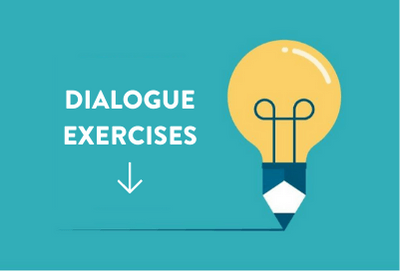
Exercise One
It’s very important to have your characters talking TOWARD something.
Here is the last line of a dialogue between two people. “Fine, I’ll do it.”
Now write a page of dialogue between these people ending in that line.
This exercise is based on William Sloane, who said, “Know what the scene is supposed to accomplish and have your characters write toward it, not in circles.”
Exercise Two
We speak differently to different people. Write a character changing their dialogue to fit when talking to these people. They are explaining why they decided to get a divorce.
- A child
- A person of authority (Parent, judge)
- A best friend
- A same-sex stranger in a bar
Exercise Three
Write the same line of dialogue from multiple types of people. The line of dialogue is:
“I’d like you to stop doing that.” Write it in the voices of all these characters:
- Brooklyn hoodlum
- Bored Housewife
- Pirate
- Surfer
- Computer Geek
- Drunk
- Rich Aristocrat
If you’d like some more dialogue exercises, please check out my post on 30 Dialogue Exercises.
Hope that helps your dialogue writing!
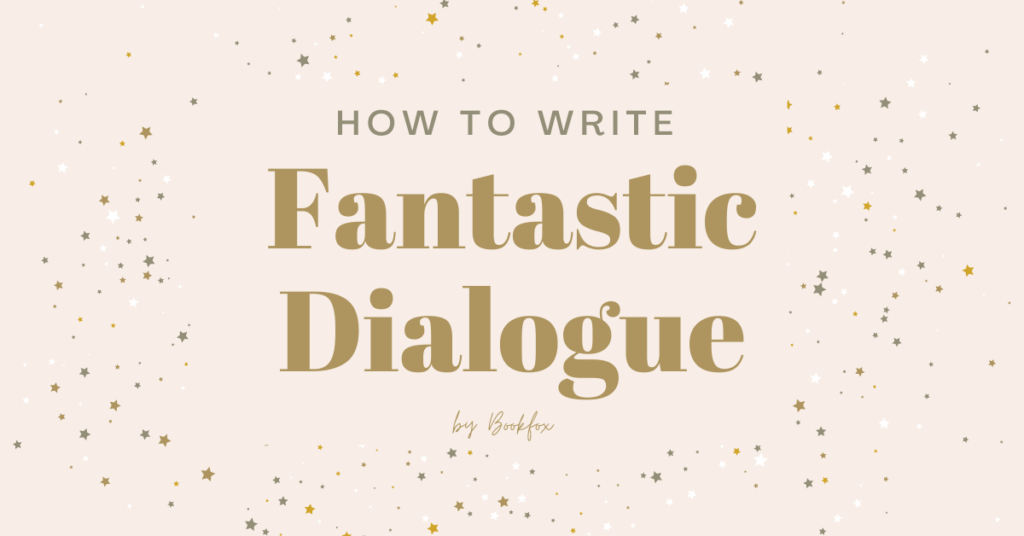
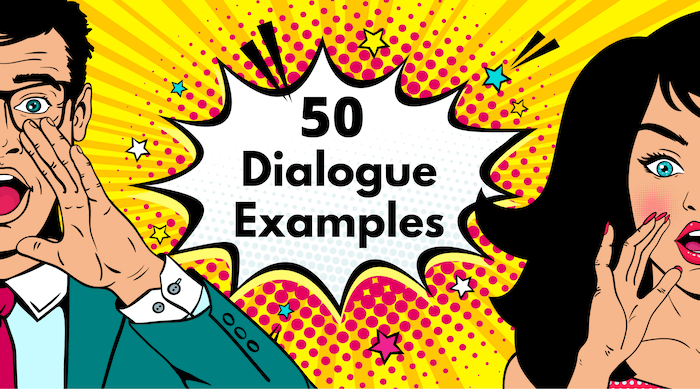

One thought on “How to Write Fantastic Dialogue: 15 Tips You’ll Never Forget”
This article is fantastic! I’ve bookmarked it and will share it with my (author) friends. Thank you for the help!